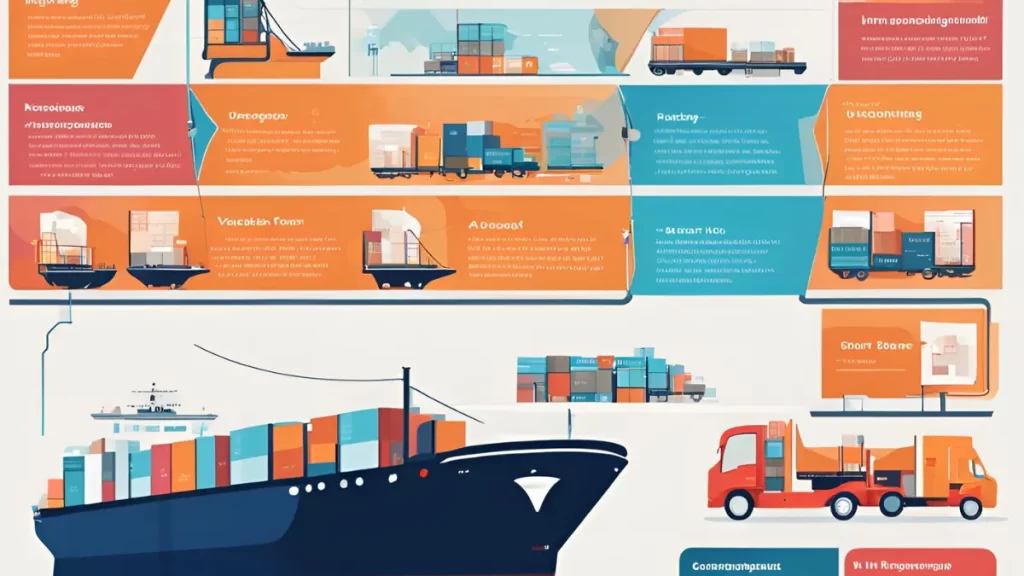n the ever-evolving landscape of supply chain management, efficiency is paramount. Businesses constantly seek innovative methods to streamline processes and reduce costs while maintaining high standards of service. One such method that has gained traction in recent years is cross-docking.
In this article, we delve into the concept of cross-docking and explore how it simplifies supply chain management while enhancing efficiency. From understanding the fundamentals of cross-docking to uncovering its benefits and best practices, we will navigate through the intricacies of this logistics strategy.
Table of Content:
Table of Content

Definition of Cross-Docking
Cross-docking is a logistics strategy that revolutionizes supply chain management by prioritizing speed, efficiency, and cost reduction. It involves the immediate transfer of products from inbound to outbound trucks, eliminating the need for long-term storage.
This strategic approach is particularly valuable in industries that rely on quick order fulfillment and face challenges with perishable goods or products with short shelf lives. By bypassing storage, cross-docking enables businesses to streamline their operations and meet the demands of today’s fast-paced market.
One of the key benefits of cross-docking is its contribution to environmental sustainability. By reducing the need for extensive warehousing and minimizing the overall energy usage, this strategy helps conserve resources and reduce greenhouse gas emissions.
How Cross-Docking Optimizes Supply Chain Operations
Cross-docking is a strategic operation that revolutionizes supply chain management by reducing storage costs and enhancing efficiency. By eliminating the need for long-term storage, goods move swiftly through the facility, resulting in faster delivery times and heightened customer satisfaction.
One of its major benefits is the preservation of product quality and freshness, particularly beneficial for perishable items like food and pharmaceuticals. Additionally, cross-docking optimizes transportation costs by consolidating shipments and maximizing container capacities, leading to significant savings.
Moreover, advanced tracking systems provide real-time visibility into the supply chain, empowering businesses to make informed decisions and promptly address disruptions. This simplified approach to logistics offers unparalleled optimization benefits, making cross-docking a cornerstone of modern supply chain management.
Pre-Distribution vs Post-Distribution Cross-Docking
Pre-distribution cross-docking and post-distribution cross-docking are two distinct approaches within the realm of cross-docking, each serving specific purposes in supply chain management. Understanding the differences between these strategies is crucial for optimizing logistics operations and ensuring efficient product flow.
1. Pre-distribution cross-docking
Pre-distribution cross-docking involves sorting, packing, and labelling products at a central hub before they are shipped to various distribution centers. This method is particularly advantageous for businesses that operate multiple distribution points. By centralizing the sorting and packaging process, companies can streamline operations and ensure that each distribution center receives the required products efficiently.
2. Post-distribution cross-docking
Post-distribution cross-docking involves re-routing or re-sorting products at the central hub after leaving the initial distribution center. This flexibility provides businesses with the ability to adapt to real-time changes in demand or address issues such as product recalls.
Comparing Dropshipping, Direct Shipment, and Cross-Docking
When it comes to managing the movement of goods, there are several strategies to consider. Dropshipping, direct shipment, and cross-docking are three distinct approaches that businesses can explore. Let’s take a closer look at each of them and compare their features.
Dropshipping
Dropshipping involves shipping products directly from the manufacturer to the customer, without the need for warehousing or intermediary storage. This approach allows businesses to minimize inventory holding costs and streamline their supply chain, as products are shipped to customers as orders are received.
Direct shipment
In direct shipment, products are shipped from the manufacturer directly to the retailer or end-consumer, bypassing intermediate storage facilities. This strategy reduces handling time and enables faster delivery, as products are transported directly to their final destination.
Direct shipment can be advantageous for businesses with established distribution networks or those aiming to provide a seamless customer experience by minimizing unnecessary steps in the supply chain.
Cross-docking
Cross-docking, as mentioned earlier, emphasizes the efficient handling and movement of goods to optimize the supply chain. It involves directly transferring products from inbound to outbound vehicles, avoiding the need for long-term storage.
Cross-docking streamlines operations, reduces storage costs, and improves overall supply chain efficiency. It is particularly effective for industries dealing with perishable goods or those looking to enhance delivery speed and minimize inventory.
Types of Cross-Docking: Maximizing Efficiency in Supply Chain
Cross-docking offers various configurations that can be tailored to specific logistical needs, maximizing efficiency in the supply chain. By adopting different types of cross-docking, businesses can streamline their operations and optimize their supply chain management processes. Let’s explore the different types:
1. Manufacturing cross-docking
In manufacturing cross-docking, materials are directly received from multiple suppliers and immediately transported to the manufacturing facility. This eliminates the need for storage and reduces handling time, allowing for faster production cycles and increased efficiency.
2. Distribution cross-docking
Distribution cross-docking involves sorting and dispatching products from multiple manufacturers to customers or retail chains. This type of cross-docking enables the consolidation of smaller shipments into larger ones, reducing transportation costs and improving overall distribution efficiency.
3. Pre-distribution cross-docking
Pre-distribution cross-docking occurs at a central hub where products are sorted and packed before being shipped to distribution centers. By eliminating the need for long-term storage, this type of cross-docking minimizes handling costs and ensures products reach their destinations on time.
4. Post-distribution cross-docking
Post-distribution cross-docking allows for re-routing or re-sorting of products after they leave the initial distribution center. This flexibility enables businesses to quickly adapt to changes in demand or address issues such as product recalls, enhancing overall supply chain responsiveness.
5. Transportation cross-docking
Transportation cross-docking consolidates smaller loads into larger shipments, improving transport efficiency and reducing transportation costs. By reducing the number of individual shipments, businesses can optimize resources and enhance the overall sustainability of their supply chain.
6. Retail cross-docking
Retail cross-docking involves sorting and dispatching products directly to various retail outlets. This type of cross-docking enables retailers to receive products quickly and efficiently, minimizing on-site inventory and improving their ability to respond to changing customer demands.
7. Hybrid cross-docking
Hybrid cross-docking combines elements from various types to cater to specific logistical demands. By customizing cross-docking strategies, businesses can create efficient and responsive supply chains that align with their unique operational requirements.
Applications of Cross-Docking: Situations and Industries Where It’s Most Effective
Cross-docking is a versatile strategy that can be applied across various industries and situations. It is particularly effective in sectors such as retail, manufacturing, distribution, and logistics.
Retailers can keep on-site inventory to a minimum, improving operational agility and reducing storage costs. By implementing cross-docking, retailers can receive shipments from suppliers and quickly dispatch them to their stores or directly to customers, ensuring faster order fulfillment and maintaining optimal stock levels.
Manufacturers can also benefit from cross-docking by promptly receiving materials from multiple suppliers. This ensures a smooth production process and eliminates the need for excessive inventory.
With cross-docking, manufacturers can receive the required materials just-in-time, reducing the risk of stockouts, minimizing workspace requirements, and optimizing their production lines.
In the distribution sector, cross-docking enables companies to handle a diverse range of products efficiently. Distributors can receive shipments from multiple suppliers, sort them, and quickly dispatch them to customers or retail chains. This streamlined process reduces handling time, minimizes the risk of product damage, and improves overall delivery efficiency.
Cross-docking is particularly valuable in industries where demand is dynamic and quick turnaround times are crucial. The ability to swiftly transfer products from inbound to outbound vehicles allows businesses to meet customer requirements on time and stay ahead of the competition.
Implementing cross-docking in these industries enhances supply chain operations by minimizing storage costs, reducing the risk of stockouts, improving order fulfillment, and optimizing overall efficiency.
Implementing Cross-Docking in Your Operations: Essential Considerations for Success
Implementing cross-docking can greatly boost supply chain efficiency, but success requires careful planning. Here are key factors to consider:
- Advanced planning: Sync inbound and outbound schedules to minimize wait times and optimize flow.
- Real-time tracking systems: Invest in systems for better visibility, enabling proactive decision-making.
- Effective communication: Ensure clear collaboration between suppliers, carriers, and internal teams.
- Optimized layout and workflow: Design compact docks, streamline staging areas, and use tools for efficient movement.
By addressing these factors, you can seamlessly integrate cross-docking into your operations, leading to enhanced efficiency and overall success.
Conclusion
Cross-docking emerges as a pivotal strategy, simplifying logistics while elevating operational effectiveness. Throughout this article, we’ve traversed the complexities of cross-docking, exploring its benefits, best practices, and various configurations.
As businesses strive for streamlined operations and reduced costs, the importance of optimized supply chain management cannot be overstated. HashMicro ERP software is designed to complement and enhance cross-docking operations, providing real-time tracking, streamlined communication, and optimized workflow management.
Discover how HashMicro ERP software can revolutionize your logistics operations, propelling your business toward unparalleled success. Try the free demo now!


































